Selected Clips
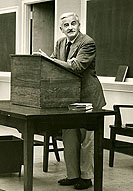
Below are some of the best moments from the hours of material in this archive: about 230 clips, selected from the total of over 1400
answers Faulkner gave to his UVA audiences. About three-quarters of them focus on a specific novel or story, 23 of his works in all. In the final sixty
clips Faulkner gives his views on other subjects, including writing and art, other writers, the South and the Civil Rights Movement.
By clicking on the play icons, you’ll be taken to a transcript, where you can both hear and read the questions and his answers. To come back to this page to
select other clips to listen to, use the BACK button on your browser.
Flags in the Dust
Faulkner was not asked any questions about a novel with this title, for the reason that this text was not published until 1973. During Faulkner’s residencies at Virginia, his first Yoknapatawpha novel was still being published as Sartoris, the title given to the shortened version of the Flags manuscript that Faulkner’s agent Ben Wasson prepared according to the stipulations of Harcourt, Brace & Company, who published the book , after a dozen other firms had rejected it, in 1929.
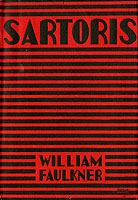
First Edition Cover
-
 Best book to start with? (23 May 1958)
Best book to start with? (23 May 1958)
-
 Confederate reminiscences? (28 April 1958)
Confederate reminiscences? (28 April 1958)
-
 Missing generation of
Sartorises? (28 April 1958)
Missing generation of
Sartorises? (28 April 1958)
-
 Old Man Falls’ dialect? (6 May 1958)
Old Man Falls’ dialect? (6 May 1958)
-
 Simon’s character? (8 May 1958)
Simon’s character? (8 May 1958)
-
 Col. Falkner & Col.
Sartoris? (28 April 1958)
Col. Falkner & Col.
Sartoris? (28 April 1958)
-
 Byron Snopes & Narcissa
Benbow? (28 April 1958)
Byron Snopes & Narcissa
Benbow? (28 April 1958)
-
 Old Bayard’s wen? (28 April 1958)
Old Bayard’s wen? (28 April 1958)
-
 Old Bayard’s longevity? (28 April 1958)
Old Bayard’s longevity? (28 April 1958)
-
 Young Bayard’s cowardice?(28 April 1958)
Young Bayard’s cowardice?(28 April 1958)
-
 The
Sartorises’ future? (28 April 1958)
The
Sartorises’ future? (28 April 1958)
The Sound and the Fury
Published by Jonathan Cape and Harrison Smith in 1929, this is one of Faulkner’s most difficult
novels, and so not surprisingly, it is one of the books people at Virginia asked the most questions about. (At one session he
was even asked about the dramatic image on the cover of the first edition’s dust jacket, below left
 .) He began his last UVA session, 23 May 1958, by
reading a ten-minute excerpt from the novel's Easter section
.) He began his last UVA session, 23 May 1958, by
reading a ten-minute excerpt from the novel's Easter section
 .
.
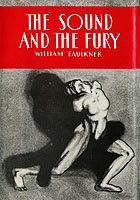
First Edition Cover
-
 Which book do you consider your best? (13 April 1957)
Which book do you consider your best? (13 April 1957)
-
 Why doesn’t Caddy have her own section? (15 February 1957)
Why doesn’t Caddy have her own section? (15 February 1957)
-
 How should we feel about Caddy? (15 February 1957)
How should we feel about Caddy? (15 February 1957)
-
 Why do you feel so strongly about Caddy? (2 May 1958)
Why do you feel so strongly about Caddy? (2 May 1958)
-
 Why does the novel include so many italics and so little grammar? (27 April 1957)
Why does the novel include so many italics and so little grammar? (27 April 1957)
-
 Did Quentin really talk to his father about committing incest? (2 May 1958)
Did Quentin really talk to his father about committing incest? (2 May 1958)
-
 How do Quentin and Dilsey approach time? (2 May 1958)
How do Quentin and Dilsey approach time? (2 May 1958)
-
 What do the shadows in Quentin’s section signify? (15 February 1957)
What do the shadows in Quentin’s section signify? (15 February 1957)
-
 What is the significance of the novel’s dates? (13 March 1957)
What is the significance of the novel’s dates? (13 March 1957)
-
 What is the significance of the Easter service? (2 May 1958)
What is the significance of the Easter service? (2 May 1958)
-
 What does Dilsey mean by “the first and the last”? (2 May 1958)
What does Dilsey mean by “the first and the last”? (2 May 1958)
-
 Do T.P. and Versh’s names stand for anything? (2 May 1958)
Do T.P. and Versh’s names stand for anything? (2 May 1958)
-
 What role does Mr. Compson play in Quentin’s life? (15 February 1957)
What role does Mr. Compson play in Quentin’s life? (15 February 1957)
-
 What is Jason's role in Miss Quentin’s story? (2 May 1958)
What is Jason's role in Miss Quentin’s story? (2 May 1958)
-
 Which people are doomed? (2 May 1958; the one time on the tapes Faulkner laughs)
Which people are doomed? (2 May 1958; the one time on the tapes Faulkner laughs)
-
 Does this novel really suggest “man will prevail”? (15 February 1957)
Does this novel really suggest “man will prevail”? (15 February 1957)
-
 Who will prevail? (15 February 1957)
Who will prevail? (15 February 1957)
-
 How are your old southern families flawed? (26 February 1958)
How are your old southern families flawed? (26 February 1958)
-
 Is Jason a bastard? (15 April 1957)
Is Jason a bastard? (15 April 1957)
As I Lay Dying
This novel was published by Jonathan Cape and Harrison Smith in the fall, 1930. Many of the best questions Faulkner was asked about it by UVA audiences were on the tapes that have been lost; you can read what he said in answer to them in the book Faulkner in the University. Here is a sampling of his comments on the novel that you can hear in this archive.
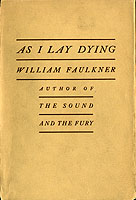
First Edition Cover
-
 The novel as a
“tour de force.” (30 May 1957)
The novel as a
“tour de force.” (30 May 1957)
-
 How similar are the Compson and Bundren families? (5 June 1957)
How similar are the Compson and Bundren families? (5 June 1957)
-
 Are the novel’s 13 characters separate parts of one man? (15 April 1957)
Are the novel’s 13 characters separate parts of one man? (15 April 1957)
-
 Why is Anse so shiftless? (24 April 1958)
Why is Anse so shiftless? (24 April 1958)
-
 Which of Addie’s children loved her the most? (2 May 1958)
Which of Addie’s children loved her the most? (2 May 1958)
-
 What is the significance of Vardaman’s fish? (2 May 1957)
What is the significance of Vardaman’s fish? (2 May 1957)
-
 What is the significance of [Cash’s] broken leg? (5 June 1957)
What is the significance of [Cash’s] broken leg? (5 June 1957)
-
 What made Darl act as he did? (2 May 1957)
What made Darl act as he did? (2 May 1957)
-
 Why do you select such unusual characters? (7 May 1958)
Why do you select such unusual characters? (7 May 1958)
-
 Why do you use
childlike characters like Benjy or Vardaman? (13 May 1957)
Why do you use
childlike characters like Benjy or Vardaman? (13 May 1957)
Early Short Stories
“A Rose for Emily”

First Edition Cover
This story was first published in Forum, 30 April 1930, and was slightly revised for publication in These Thirteen (1931), Faulkner’s first collection of short stories.
“Red Leaves”
Originally published in The Saturday Evening Post, 25 October 1930, this story was slightly revised for publication in These Thirteen. The “Indian story” “A Justice” also appeared in that collection. The other “Indian stories” that Faulkner is asked about – “Lo!” and “A Courtship” – were published later, in 1934 and 1948, respectively.
“That Evening Sun”
Originally titled “That Evening Sun Go Down” (which made the connection W.C. Handy’s song, “St. Louis Blues,” still more overt), this story was first published in the American Mercury magazine, March 1931.
Other Early Stories
“Dry September” was first published in Scribner’s magazine, January 1931; the one question about it on the tapes follows an answer about how he uses “the South” as his setting because he knows it well, but “people are the same everywhere,” and his fiction is more about “human” than regional issues. “Ad Astra” first appeared in American Caravan (1931). “Carcassonne” and “All the Dead Pilots” were both published for the first time in These Thirteen.
Sanctuary
This novel was published by Jonathan Cape and Harrison Smith in February, 1931. Faulkner told half a dozen different audiences at Virginia essentially the same story about its composition that you can hear on the first clip below. While you can’t believe everything he says there, he did write a version of a book before writing As I Lay Dying, which he revised in late 1930.
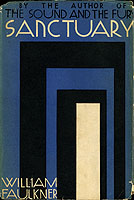
First Edition Cover
Light in August
This novel was published by Harrison Smith and Robert Haas in October, 1932.
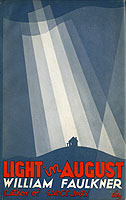
First Edition Cover
-
 What does the
title mean (1)? (6 May 1958)
What does the
title mean (1)? (6 May 1958)
-
 What does the
title mean (2)? (27 April 1957)
What does the
title mean (2)? (27 April 1957)
-
 Lena as a pagan
character. (30 May 1957)
Lena as a pagan
character. (30 May 1957)
-
 What did this
story begin with? (13 April 1957)
What did this
story begin with? (13 April 1957)
-
 Is Joe Christmas a
Christ figure? (27 April 1957)
Is Joe Christmas a
Christ figure? (27 April 1957)
-
 Is Christmas an
Oedipus figure? (13 April 1957)
Is Christmas an
Oedipus figure? (13 April 1957)
-
 Was Christmas part
“Negro”? (13 April 1957)
Was Christmas part
“Negro”? (13 April 1957)
-
 What about Gavin
Stevens’ racial explanation? (13 April 1957)
What about Gavin
Stevens’ racial explanation? (13 April 1957)
-
 Does Hightower
achieve salvation at the end? (13 April 1957)
Does Hightower
achieve salvation at the end? (13 April 1957)
-
 Why do you tell
this story in the present tense? (13 April 1957)
Why do you tell
this story in the present tense? (13 April 1957)
-
 Does the novel
argue that life is inevitably tragic? (27 April 1957)
Does the novel
argue that life is inevitably tragic? (27 April 1957)
-
 Are all the
characters looking for love? (27 April 1957)
Are all the
characters looking for love? (27 April 1957)
Absalom, Absalom!
Random House published the novel in October, 1936 (about five months after Macmillan published Margaret Mitchell’s Gone with the
Wind). Not surprisingly, UVA audiences had lots of questions about Absalom, but in the 1957 sessions Faulkner sometimes answered that he
didn’t remember this novel very well
 . Apparently before beginning his second term as Writer-in-Residence in 1958 he decided to re-read it
– despite having said a number of times that the books he was glad he never had to read again were the ones he himself had written
. Apparently before beginning his second term as Writer-in-Residence in 1958 he decided to re-read it
– despite having said a number of times that the books he was glad he never had to read again were the ones he himself had written
 .
.
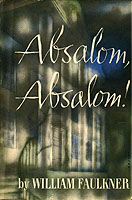
First Edition Cover
-
 Was the novel
hard to write? (15 May 1958)
Was the novel
hard to write? (15 May 1958)
-
 When did you
think of the title? (13 April 1957)
When did you
think of the title? (13 April 1957)
-
 Do any of the
story tellers have the right view? (8 May 1958)
Do any of the
story tellers have the right view? (8 May 1958)
-
 Who is the
novel’s central character? (13 April 1957)
Who is the
novel’s central character? (13 April 1957)
-
 What is Sutpen
questing for? (7 March 1957)
What is Sutpen
questing for? (7 March 1957)
-
 Is Quentin the
same as in The Sound and the Fury? (8 May 1958)
Is Quentin the
same as in The Sound and the Fury? (8 May 1958)
-
 How is this novel
Quentin’s story? (8 May 1958)
How is this novel
Quentin’s story? (8 May 1958)
-
 How much of
Quentin and Shreve’s reconstruction true? (13 April 1957)
How much of
Quentin and Shreve’s reconstruction true? (13 April 1957)
-
 When did Bon know
Sutpen was his father? (27 April 1957)
When did Bon know
Sutpen was his father? (27 April 1957)
-
 Why can’t
Sutpen acknowledge Bon as his son? (8 May 1958)
Why can’t
Sutpen acknowledge Bon as his son? (8 May 1958)
-
 When did Bon know
his was part Negro? (8 May 1958)
When did Bon know
his was part Negro? (8 May 1958)
-
 Did Bon love
Judith, or was he using her? (8 May 1958)
Did Bon love
Judith, or was he using her? (8 May 1958)
-
 Is Sutpen a
villain? (13 April 1957)
Is Sutpen a
villain? (13 April 1957)
-
 What is the
significance of Sutpen wrestling his “Negro servants”? (13 April 1957)
What is the
significance of Sutpen wrestling his “Negro servants”? (13 April 1957)
-
 Does the
novel’s “racial situation” parallel that of the South? (27 April 1957)
Does the
novel’s “racial situation” parallel that of the South? (27 April 1957)
-
 Why is Wash Jones
the one who kills Sutpen? (13 April 1957)
Why is Wash Jones
the one who kills Sutpen? (13 April 1957)
-
 Why did Mr.
Coldfield retreat into his attic? (8 May 1958)
Why did Mr.
Coldfield retreat into his attic? (8 May 1958)
-
 What kind of
poetry does Miss Rosa write? (12 May 1958)
What kind of
poetry does Miss Rosa write? (12 May 1958)
The Unvanquished
All but the first story in this book were originally published between 1934 and 1936 as separate short stories (five in The Saturday Evening Post and one in Scribner’s). Random House published the novel, as the book is usually categorized, in February 1938. All but two of the questions below were asked at a meeting of Irby Cauthen’s First-Year English Class, though many of the voices don’t sound like freshmen. It’s clear that when Faulkner visited classrooms, faculty members and others often dropped in to participate.
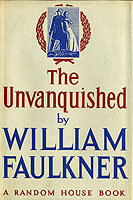
First Edition Cover
-
 Which of
your books would you advise someone to read first? (15 February 1957)
Which of
your books would you advise someone to read first? (15 February 1957)
-
 Did you
write the stories as stories or parts of a novel? (28 April 1958)
Did you
write the stories as stories or parts of a novel? (28 April 1958)
-
 What is your
opinion of Col. Sartoris as a man? (28 April 1958)
What is your
opinion of Col. Sartoris as a man? (28 April 1958)
-
 What did you
make Ringo smarter than Bayard? (28 April 1958)
What did you
make Ringo smarter than Bayard? (28 April 1958)
-
 How do race
and circumstance affect the two boys? (28 April 1958)
How do race
and circumstance affect the two boys? (28 April 1958)
-
 What does
the ruined train signify? (28 April 1958)
What does
the ruined train signify? (28 April 1958)
-
 Were there
many girls in the Civil War like Drusilla? (28 April 1958)
Were there
many girls in the Civil War like Drusilla? (28 April 1958)
-
 Was there
any romantic attraction between Drusilla and Bayard? (28 April 1958)
Was there
any romantic attraction between Drusilla and Bayard? (28 April 1958)
-
 What is the
significance of the sprig of verbena? (28 April 1958)
What is the
significance of the sprig of verbena? (28 April 1958)
-
 What are
Bayard's thoughts about his father's violent death? (1 May 1958)
What are
Bayard's thoughts about his father's violent death? (1 May 1958)
-
 How does
Aunt Jenny feel about Bayard's choice at the end? (28 April 1958)
How does
Aunt Jenny feel about Bayard's choice at the end? (28 April 1958)
-
 Does the
verbena signify the tradition that Bayard rejects? (28 April 1958)
Does the
verbena signify the tradition that Bayard rejects? (28 April 1958)
-
 Has
Hollywood ever expressed any interest in these stories? (28 April 1958)
Has
Hollywood ever expressed any interest in these stories? (28 April 1958)
The Wild Palms|The Old Man
Faulkner was asked only a few questions about The Wild Palms as the story of Charlotte and Harry, but on May 20th, 1957, he attended a
freshman English class where the students had read “The Old Man,” the interpolated story of the tall convict and the pregnant woman.
By the mid-1950’s that narrative had been published several times by itself, though as Faulkner said in another UVA session, that was the
publisher's idea, not his  . At the instructor’s request, Faulkner read to the students that story’s last ten paragraphs
. At the instructor’s request, Faulkner read to the students that story’s last ten paragraphs  . For the remainder of the period he answered questions about the tale, 32 in all. You can read them all, in sequence, by using the
archive’s BROWSE page; below are a dozen of them, along with one from a different event.
. For the remainder of the period he answered questions about the tale, 32 in all. You can read them all, in sequence, by using the
archive’s BROWSE page; below are a dozen of them, along with one from a different event.
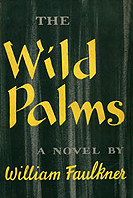
First Edition Cover
-
 How are the two narratives related? (15 February 1957)
How are the two narratives related? (15 February 1957)
-
 How are the two pairs of couples related? (20 May 1957)
How are the two pairs of couples related? (20 May 1957)
-
 How did you write "The Old Man"? (20 May 1957)
How did you write "The Old Man"? (20 May 1957)
-
 Is the title "The Old Man"? (20 May 1957)
Is the title "The Old Man"? (20 May 1957)
-
 Have you ever experienced a flood on the Mississippi? (20 May 1957)
Have you ever experienced a flood on the Mississippi? (20 May 1957)
-
 Have you had experience with the people of the Delta? (20 May 1957)
Have you had experience with the people of the Delta? (20 May 1957)
-
 Why don't the characters have names? (20 May 1957)
Why don't the characters have names? (20 May 1957)
-
 Did the tall convict believe in God? (20 May 1957)
Did the tall convict believe in God? (20 May 1957)
-
 What is the source of his strength? (20 May 1957)
What is the source of his strength? (20 May 1957)
-
 What is his attitude toward women? (20 May 1957)
What is his attitude toward women? (20 May 1957)
-
 Does the story show a miscarriage of justice? (20 May 1957)
Does the story show a miscarriage of justice? (20 May 1957)
-
 What was your purpose in making the woman pregnant? (20 May 1957)
What was your purpose in making the woman pregnant? (20 May 1957)
-
 Is the story both funny and about an injustice? (20 May 1957)
Is the story both funny and about an injustice? (20 May 1957)
The Hamlet
The first story Faulkner chose to read to a Virginia audience came from this novel; on 7 March 1957, three weeks after beginning his first term in
residence, he read an abridged version of “Spotted Horses” to the English Club  . Despite this, he was asked relatively few questions about the book. Most of them are listed here.
. Despite this, he was asked relatively few questions about the book. Most of them are listed here.
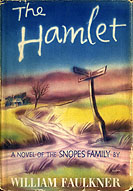
First Edition Cover
-
 Did you originally think of the novel as part of a trilogy? (27 April 1957)
Did you originally think of the novel as part of a trilogy? (27 April 1957)
-
 Is Eula a larger-than-life character? (7 March 1957)
Is Eula a larger-than-life character? (7 March 1957)
-
 What is Ike Snopes supposed to be? (8 May 1957)
What is Ike Snopes supposed to be? (8 May 1957)
-
 Are Flem Snopes and Thomas Sutpen similar characters? (27 April 1957)
Are Flem Snopes and Thomas Sutpen similar characters? (27 April 1957)
-
 Is Snopesism what will prevail? (7 March 1957)
Is Snopesism what will prevail? (7 March 1957)
-
 What do the spotted horses symbolize? (13 March 1957)
What do the spotted horses symbolize? (13 March 1957)
-
 Faulkner's own spotted horse. (7 March 1957)
Faulkner's own spotted horse. (7 March 1957)
Go Down, Moses
Most of the questions Faulkner was asked about the stories in this book focused on “The Bear,” which was one of the most frequently
taught American texts during the 1950’s. There are also a number of questions about “Was,” the story with which the book
opens. At his very first UVA session Faulkner was asked about the poker hand at the end of this tale, but admitted in his reply that “I
don’t remember the story too well”  . Yet later that semester he chose to read “Was” to two different audiences (the best version for
listening is the one from 8 May 1957
. Yet later that semester he chose to read “Was” to two different audiences (the best version for
listening is the one from 8 May 1957  ). As Go Down, Moses suggests clearly, it’s
important to note what those various readers at the time Faulkner was in residence did not ask about, as well as what they did. SEARCHing the
archive for “The Bear,” for example, turns up over fifty hits; on the other hand, he was not asked even once about Lucas Beauchamp.
). As Go Down, Moses suggests clearly, it’s
important to note what those various readers at the time Faulkner was in residence did not ask about, as well as what they did. SEARCHing the
archive for “The Bear,” for example, turns up over fifty hits; on the other hand, he was not asked even once about Lucas Beauchamp.

First Edition Cover
-
 How did Uncle Buck end up marrying Sophonsiba? (11 March 1957)
How did Uncle Buck end up marrying Sophonsiba? (11 March 1957)
-
 When did you begin writing "The Bear"? (8 May 1958)
When did you begin writing "The Bear"? (8 May 1958)
-
 How should we see the conflict between man and wilderness? (8 May 1958)
How should we see the conflict between man and wilderness? (8 May 1958)
-
 Could you discuss the scene between Ike and his wife? (8 May 1958)
Could you discuss the scene between Ike and his wife? (8 May 1958)
-
 Why did Boon kill Sam Fathers? (11 March 1957)
Why did Boon kill Sam Fathers? (11 March 1957)
-
 Did Ike fulfill his destiny? (11 March 1957)
Did Ike fulfill his destiny? (11 March 1957)
-
 Is Ike a Christ figure? (1 May 1958)
Is Ike a Christ figure? (1 May 1958)
-
 How is Part 4 related to the rest of "The Bear"? (15 February 1957)
How is Part 4 related to the rest of "The Bear"? (15 February 1957)
-
 Is Ike's predicament that of modern man? (24 April 1958)
Is Ike's predicament that of modern man? (24 April 1958)
-
 Is Ike's comment
about interracial marriage still true? (11 March 1957)
Is Ike's comment
about interracial marriage still true? (11 March 1957)
-
 Do you share Ike's view that there's a curse on the land? (8 May 1958)
Do you share Ike's view that there's a curse on the land? (8 May 1958)
Intruder in the Dust
This novel was published by Random House in 1948. The film version that Faulkner mentions in the last answer below premiered in 1949 (the play he refers to there is Requiem for a Nun). 1954, which Faulkner mentions in answering the fourth question, was, as his audience didn’t need to be reminded, the year of the Supreme Court’s Brown vs. Board of Education decision. The only one of the novel’s characters that Faulkner’s UVA audiences seem to have asked him about is Gavin Stevens, whose thoughts about the southern system of segregation in the face of outside pressure to change seemed especially timely in the years Faulkner was in residence in Virginia.
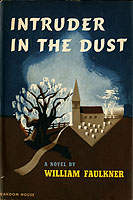
First Edition Cover
-
 How did this novel start? (13 May 1957)
How did this novel start? (13 May 1957)
-
 Is Gavin based on a real person? (12 May 1958)
Is Gavin based on a real person? (12 May 1958)
-
 Is Gavin the same in Intruder and The Town? (13 May 1957)
Is Gavin the same in Intruder and The Town? (13 May 1957)
-
 Do you agree with Gavin’s politics? (12 May 1958)
Do you agree with Gavin’s politics? (12 May 1958)
-
 Is the Southern
attitude toward "the Negro" still the same? (12 May 1958)
Is the Southern
attitude toward "the Negro" still the same? (12 May 1958)
-
 Is South changing too fast or too slowly? (11 March 1957)
Is South changing too fast or too slowly? (11 March 1957)
-
 Is your novel trying to make a point about segregation? (7 May 1958)
Is your novel trying to make a point about segregation? (7 May 1958)
-
 Do you like the movie versions of your work? (12 May 1958)
Do you like the movie versions of your work? (12 May 1958)
Requiem for a Nun
Published by Random House on 27 September 1951, this novel is a kind of sequel to Sanctuary, though as Faulkner explains in the first clip below, he did not have it in mind when writing the first novel two decades earlier. Stylistically, it is in the form of a drama interspersed with dense prose accounts of the history of Yoknapatawpha. By the time Faulkner came to Virginia, the dramatic portions of the novel had been performed is several European countries, and the final two questions here refer to that aspect of this story.
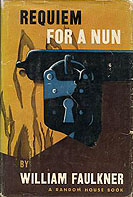
First Edition Cover
A Fable
Published 2 August 1954, this novel won both the Pulitzer Prize and the National Book Award in 1955. In our time it is infrequently taught,
but eight different audiences at UVA asked him a total of 17 questions about it – perhaps because, until The Town appeared in 1958, it was
his most recent novel, or because
the novel's overtly allegorical aesthetic fit so well inside their interest in symbols and “meanings” – and at least one person in
those audiences thought it was his “greatest book”  Unfortunately, in many of his responses
Faulkner fell back on the formulae you can hear in the first three answers below.
Unfortunately, in many of his responses
Faulkner fell back on the formulae you can hear in the first three answers below.
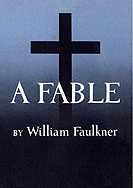
First Edition Cover
-
 How do you feel about the
novel? (13 March 1957)
How do you feel about the
novel? (13 March 1957)
-
 What is the novel's
"idea"? (25 February 1957)
What is the novel's
"idea"? (25 February 1957)
-
 Why did you set the novel
in Europe? (15 February 1957)
Why did you set the novel
in Europe? (15 February 1957)
-
 What kind of character is
the general? (13 March 1957)
What kind of character is
the general? (13 March 1957)
-
 Is the horse also
symbolical? (13 March 1957)
Is the horse also
symbolical? (13 March 1957)
-
 Is the crufixion image
more positive in this novel? (15 April 1957)
Is the crufixion image
more positive in this novel? (15 April 1957)
-
 Is the book's style
deliberately "biblical"? (5 June 1957)
Is the book's style
deliberately "biblical"? (5 June 1957)
-
 Is the novel didactic, or
a kind of sermon? (24 April 1958)
Is the novel didactic, or
a kind of sermon? (24 April 1958)
The Town
This novel was published by Random House on 1 May 1957, right in the middle of Faulkner's first term as Writer-in-Residence. The day before
that, April 30th, he read “The Waifs,” a story excerpted from the novel, to the Jefferson Society  , and at the end of that term he twice used the passage in
the novel where Gavin Stevens looks back at Yoknapatawpha from that ridge north of “the town” to provide a kind of valedictory to his stay
at Virginia (the second of those two readings, from June 5th, has the best sound
, and at the end of that term he twice used the passage in
the novel where Gavin Stevens looks back at Yoknapatawpha from that ridge north of “the town” to provide a kind of valedictory to his stay
at Virginia (the second of those two readings, from June 5th, has the best sound  ). The first question below was asked before the novel appeared.
). The first question below was asked before the novel appeared.
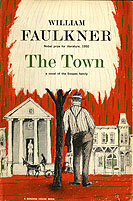
First Edition Cover
-
 Does "The Waifs" have a
larger meaning? (30 April 1957)
Does "The Waifs" have a
larger meaning? (30 April 1957)
-
 Is there a Snopes named
Montgomery Ward? (7 March 1957)
Is there a Snopes named
Montgomery Ward? (7 March 1957)
-
 Is Flem going to be
respectable from now on? (8 May 1957)
Is Flem going to be
respectable from now on? (8 May 1957)
-
 Why did you use a child as one
of the novel's three narrators? (13 May 1957)
Why did you use a child as one
of the novel's three narrators? (13 May 1957)
-
 Does Charles Mallison change
during the novel? (13 May 1957)
Does Charles Mallison change
during the novel? (13 May 1957)
-
 Is Gavin Stevens' character
less likeable in this book? (13 May 1957)
Is Gavin Stevens' character
less likeable in this book? (13 May 1957)
-
 What time period does the
novel cover? (13 May 1957)
What time period does the
novel cover? (13 May 1957)
-
 Are Gavin and Quentin Compson
similar as "knights"? (13 May 1957)
Are Gavin and Quentin Compson
similar as "knights"? (13 May 1957)
-
 Why did Eula commit
suicide? (30 May 1957)
Why did Eula commit
suicide? (30 May 1957)
-
 Did you invent new Snopeses
for this novel? (5 June 1957)
Did you invent new Snopeses
for this novel? (5 June 1957)
Later Short Stories
“Shingles for the Lord”
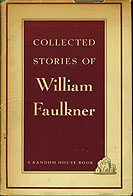
First Edition Cover
This story was first published in The Saturday Evening Post, 13 February 1943. Faulkner read it twice during his first Spring term as Writer-in-Residence: on 15 April 1957 to an audience of people from other Virginia colleges, and on 25 April to an audience at Mary Washington College. The second reading is a bit shorter and livelier; both can be accessed from the archive’s BROWSE page. After these readings he was asked only one question about the story:
“Race at Morning”
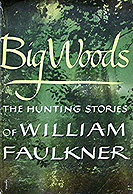
First Edition Cover
This story was first published March, 1955, in The Saturday Evening Post, and then revised for publication later that year with the other hunting
stories in The Big Woods. It is the story Faulkner himself chose to read when John Coleman invited him to attend his undergraduate writing
course on 26 February 1958, early in his second term in residence  . After the reading, he was asked a baker's dozen questions about the story, six of which are included here:
. After the reading, he was asked a baker's dozen questions about the story, six of which are included here:
-
 How did you write this
story? (26 February 1958)
How did you write this
story? (26 February 1958)
-
 Why does the narrative
unfold in the order it does? (26 February 1958)
Why does the narrative
unfold in the order it does? (26 February 1958)
-
 Are there double entendres
in the title of the story? (26 February 1958)
Are there double entendres
in the title of the story? (26 February 1958)
-
 Faulkner describes the
relationship between Mr. Ernest and the boy. (26 February 1958)
Faulkner describes the
relationship between Mr. Ernest and the boy. (26 February 1958)
-
 How to they change each
other? (26 February 1958)
How to they change each
other? (26 February 1958)
-
 What are they really
hunting? (26 February 1958)
What are they really
hunting? (26 February 1958)
Other Subjects
Some Comments on His Writing & Career
Faulkner was asked the same kind of question – and even the same question – more than once over his two years at UVA. Many of the clips below are the best version of answers he gave more than once as well. Many of the others rehearse favorite themes or repeat favorite expressions. The final one, on how mankind will “endure,” echoes his famous Nobel Prize Speech about how man will “prevail,” though I confess this version of the sentiment, which seems more spontaneous, seems even more eloquent and moving to me.
-
 How he became a writer.
(25 February 1957)
How he became a writer.
(25 February 1957)
-
 A failed poet.
(5 June 1957)
A failed poet.
(5 June 1957)
-
 "The most splendid failure."
(15 February 1957)
"The most splendid failure."
(15 February 1957)
-
 His goal as a writer.
(13 March 1957)
His goal as a writer.
(13 March 1957)
-
 The source of his characters.
(11 March 1957)
The source of his characters.
(11 March 1957)
-
 Colonel Sartoris vs Colonel Falkner.
(28 April 1958)
Colonel Sartoris vs Colonel Falkner.
(28 April 1958)
-
 The writer is demon-driven.
(13 March 1957)
The writer is demon-driven.
(13 March 1957)
-
 The origin of the writer's demon.
(7 May 1958)
The origin of the writer's demon.
(7 May 1958)
-
 Writing in Hollywood for director Howard Hawks.
(15 May 1958)
Writing in Hollywood for director Howard Hawks.
(15 May 1958)
-
 Plot vs character.
(7 March 1957)
Plot vs character.
(7 March 1957)
-
 Returning to a character from a previous work.
(13 April 1957)
Returning to a character from a previous work.
(13 April 1957)
-
 His "unusual" characters.
(7 May 1958)
His "unusual" characters.
(7 May 1958)
-
 His use of long sentences.
(15 April 1957)
His use of long sentences.
(15 April 1957)
-
 Researching the past.
(28 April 1958)
Researching the past.
(28 April 1958)
-
 Advice to young writers.
(20 May 1957)
Advice to young writers.
(20 May 1957)
-
 The function of literary critics.
(13 March 1957)
The function of literary critics.
(13 March 1957)
-
 His reception in the deep South.
(30 April 1957)
His reception in the deep South.
(30 April 1957)
-
 His relationship to Christianity.
(5 June 1957)
His relationship to Christianity.
(5 June 1957)
-
 His brooding concern for people.
(15 May 1957)
His brooding concern for people.
(15 May 1957)
-
 The truth of the human heart.
(13 April 1957)
The truth of the human heart.
(13 April 1957)
-
 The human dilemma.
(8 May 1958)
The human dilemma.
(8 May 1958)
-
 Humanity will endure.
(12 May 1958)
Humanity will endure.
(12 May 1958)
Some Comments on Other Writers
Behind Faulkner‘s remarks on Thomas Wolfe’s achievement lies his first experience as a “writer in academic residence.” In April 1947 the University of Mississippi paid him to speak to six classes there. At one session a student asked him to rank his contemporaries as writers; pressed, he put Wolfe first and Hemingway last – Wolfe, for the splendor of his failure; Hemingway, because his work lacked courage. When, to Faulkner’s surprise and consternation, his classroom remarks were published, his words about Hemingway attracted the most notice, though UVA audiences a decade later were more interested in his opinion of Wolfe. On the other hand, Hemingway’s name occurs about twice as often on the tapes. The most frequently cited name is Sherwood Anderson’s.
-
 His favorite reading.
(15 February 1957)
His favorite reading.
(15 February 1957)
-
 The artist's place in America.
(30 April 1957)
The artist's place in America.
(30 April 1957)
-
 Literary success.
(8 May 1958)
Literary success.
(8 May 1958)
-
 Thomas Wolfe as the most courageous failure.
(8 May 1957)
Thomas Wolfe as the most courageous failure.
(8 May 1957)
-
 Sherwood Anderson's place in American literature.
(15 May 1958)
Sherwood Anderson's place in American literature.
(15 May 1958)
-
 Anderson's limitations.
(21 February 1958)
Anderson's limitations.
(21 February 1958)
-
 Ernest Hemingway's achievement.
(15 May 1957 1957)
Ernest Hemingway's achievement.
(15 May 1957 1957)
-
 James Joyce.
(8 May 1958)
James Joyce.
(8 May 1958)
-
 Albert Camus.
(15 May 1958)
Albert Camus.
(15 May 1958)
-
 J. D. Salinger.
(15 May 1958)
J. D. Salinger.
(15 May 1958)
-
 The women writers he esteems.
(5 June 1957)
The women writers he esteems.
(5 June 1957)
The South & the Civil Rights Movement
Rosa Parks’ refusal to move to the back of a bus in Montgomery, Alabama, occurred fourteen months before Faulkner took up his residency at UVA. Throughout the years he was Writer-in-Residence, the steady growth of the Civil Rights Movement and the often violent reactions against it made “the South” a highly charged subject. There don’t seem to be any black voices on the tapes, but among Faulkner’ white and (to judge by their voices) southern audiences, the issues of race and cultural change occupy an increasing part of the conversation. For more on this topic, see the CONTEXTS section of the archive.
-
 His feelings about the South.
(15 April 1957)
His feelings about the South.
(15 April 1957)
-
 His feeling about the Negro in the South.
(15 May 1957)
His feeling about the Negro in the South.
(15 May 1957)
-
 The segregationist South.
(20 February 1958)
The segregationist South.
(20 February 1958)
-
 The curse upon the South.
(13 April 1957)
The curse upon the South.
(13 April 1957)
-
 Miscegenation.
(13 April 1957)
Miscegenation.
(13 April 1957)
-
 Southern writing.
(1 May 1958)
Southern writing.
(1 May 1958)
-
 The chivalric ideal.
(1 May 1958)
The chivalric ideal.
(1 May 1958)
-
 Traditional values and cultural change.
(12 May 1958)
Traditional values and cultural change.
(12 May 1958)
-
 The pace of the Civil Rights Movement.
(11 March 1957)
The pace of the Civil Rights Movement.
(11 March 1957)
-
 Brown vs the Board of Education.
( 1957)
Brown vs the Board of Education.
( 1957)
-
 Mississipppi Governor James P. Coleman.
(27 April 1957)
Mississipppi Governor James P. Coleman.
(27 April 1957)
-
 Integration and Virginia.
(20 February 1958)
Integration and Virginia.
(20 February 1958)
-
 The Southern Negroes' real ambition.
(20 February 1958)
The Southern Negroes' real ambition.
(20 February 1958)
-
 The Southern whites' real anxiety.
(20 February 1958)
The Southern whites' real anxiety.
(20 February 1958)
-
 The North's attitude about integration.
(20 February 1958)
The North's attitude about integration.
(20 February 1958)
-
 The world's opinion about the South.
(20 February 1958)
The world's opinion about the South.
(20 February 1958)
-
 Equality vs integration.
(20 February 1958)
Equality vs integration.
(20 February 1958)
-
 Legal equality vs social integration.
(13 April 1957)
Legal equality vs social integration.
(13 April 1957)
Other Comments
The need for individuals, especially artists, to resist the pressure to conform became one of Faulkner’s favorite topics in his second term as Writer-in-Residence. His May, 1958, statement about Virginia and snobs refers to a remark he made at the press conference held on 15 February 1957, his first official day in residency; the tape of that session has disappeared. For more on “McCarthyism,” or Faulkner’s work for the State Department and his trip to Greece, see the CONTEXTS section of the archive.
-
 Individualism vs conformity in the modern world.
(7 May 1958)
Individualism vs conformity in the modern world.
(7 May 1958)
-
 Virginia vs Mississippi.
(15 May 1958)
Virginia vs Mississippi.
(15 May 1958)
-
 The State Department's People-to-People Program.
(30 April 1957)
The State Department's People-to-People Program.
(30 April 1957)
-
 His trip to Greece.
(8 May 1957)
His trip to Greece.
(8 May 1957)
-
 The cultural effect of McCarthyism.
(16 May 1957)
The cultural effect of McCarthyism.
(16 May 1957)
-
 Advice for young men.
(8 May 1957)
Advice for young men.
(8 May 1957)
-
 Talking too much.
(7 May 1958)
Talking too much.
(7 May 1958)
-
 The opinions of critics (and where the last tape ends!).
(23 May 1958)
The opinions of critics (and where the last tape ends!).
(23 May 1958)

